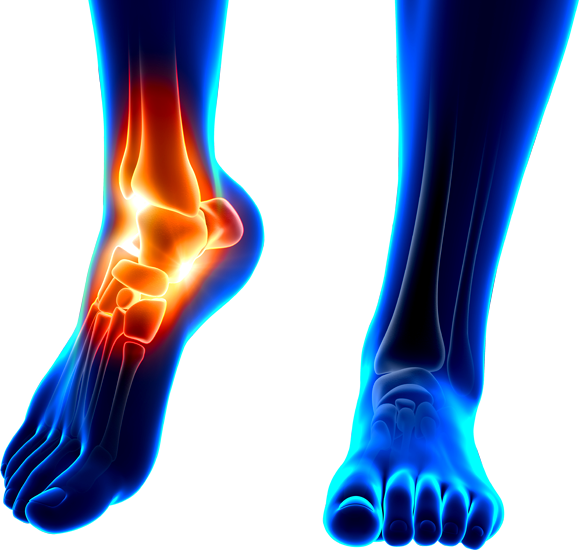Leeds Foot & Ankle Clinic
Experts in foot and ankle surgery

Bunion Surgery.
What is Bunion Surgery
A bunion is a bony bump that forms on the joint at the base of the big toe. It occurs when the big toe pushes too far across against the adjacent toe, causing the joint to become misaligned and protrude. Bunions can be painful and may affect your ability to walk or wear certain types of footwear.
When is bunion surgery recommended
Bunion surgery is typically recommended when non-surgical treatments, such as wearing appropriate footwear, using orthotic devices, or taking pain medications, have failed to relieve your symptoms.
In the clinic visit, you will undergo a thorough discussion of your foot problem and an examination of your foot. You will need some x-rays of the foot and occasionally some other imaging tests may be arranged. We will review your medical history, current medications, and any allergies you may have. It is important to inform us about any existing health conditions or medications you are taking.
The decision to undergo bunion correction surgery will be made after a detailed assessment of your condition and a discussion with you to determine if surgery is appropriate. You will be fully involved in the decision-making process and encouraged to ask questions so you fully understand the treatment options.
What are the benefits of bunion surgery
Bunion surgery aims to alleviate pain, improve the alignment of the affected joint, and enhance your ability to walk and engage in daily activities without discomfort. By correcting the bunion, surgery can also prevent the progression of the deformity and provide long-term relief of symptoms.
What are the different types of bunion surgery
- 1. Bunionectomy: This involves simply removing the bony bump, but not correcting the deformed position of the big toe. This is not usually recommended unless a shorter or less complicated procedure is needed, usually due to the potential risks or complications of performing bone realignment procedures in certain patients.
- 2. Osteotomy: This involves cutting and repositioning the bones to correct the alignment of the big toe, narrow the foot width and remove the bunion bump that is causing the deformity and pain. This is most commonly performed as a “Scarf and Akin” or a “Chevron and Akin” procedure. These terms simply describe the types of bone cuts that are made.
- 3. Fusion: This procedure involves fusing the affected joint to eliminate pain and maintain proper alignment. This is usually done when significant arthritis is present causing the bunion.
What should I expect before the surgery
You will be advised to refrain from eating or drinking for a specific period before the surgery. It is essential to follow these preoperative instructions carefully to ensure the surgery can go ahead safely on the day. If you are unsure, please ring the ward or my secretary to clarify what you need to do.
What should I expect on the day of surgery
On the day of your surgery, you will be admitted to the hospital ward by the hospital nursing and ward team. Our consultant lower limb specialist anaesthetist will discuss the anaesthesia options with you and determine the most appropriate anaesthetic for your individual case.
Most bunion surgery is performed under general anaesthetic with the addition of some local anaesthetic injections around the ankle and foot to ensure you have good pain relief after the procedure. This is known as a local anaesthetic nerve block.
You will also be seen by the physiotherapy team, who will provide you with a post-operative protective shoe and show you how to safely walk, using crutches to support and help you balance. This shoe protects your bunion correction whilst it heals, by shifting your weight bearing onto your heel using a special heel wedge platform.
The surgical procedure generally takes around 1-1.5 hours, depending on the complexity. After the surgery, you will be monitored in a recovery area until the anaesthesia wears off and you are stable to return to the ward. Once you are alert and comfortable, have had something to eat and drink and have passed urine, you will be discharged to go home.
What is the recovery process like
Recovery from bunion surgery varies from person to person, but generally the following can be expected:
-
1. Pain Management:
We will prescribe pain medications to alleviate any discomfort during the initial stages of recovery. We advise you take these regularly at the prescribed intervals, starting when you get home and continuing for the first 3-5 days. After this the painkillers can usually be reduced as your pain improves, but you should continue to take them if you feel you still need them for the first few weeks.
-
2. Elevation:
Elevate the foot, high up so it is above the level of your hip for at least the first 2 weeks after your surgery. This will reduce the swelling and pain, improve your healing and reduce your risk of wound infection and breakdown. This is very important. You should spend the majority of each day resting and elevating the foot over the first 2 weeks, and should elevate the foot on a pillow at night. Walking should be limited to just short house-bound distances during this time.
-
3. Immobilisation and Weight-Bearing:
You will need to wear a special post-operative shoe when walking to protect the surgical site and ensure proper healing. This should be worn at ALL times when you are walking or standing, but does not need to be worn at rest when sitting/elevating the foot or at night time. You will need to use this shoe for 6 weeks after your surgery.
You can take your full weight through the foot whilst in the shoe, provided it feels safe and comfortable to do so. You may need to use the crutches to help you balance or to take some weight off the foot for the initial few weeks. Be guided by your foot and your symptoms.
For the first 2-3 weeks, you should limit your walking distance to short, house-bound distances only. This will help to reduce swelling and pain and improve the healing process.
-
4. Physiotherapy:
We will recommend gentle exercises and may choose to refer you to a physiotherapist to promote joint mobility and strength. This occurs after the initial 6 weeks, once we progress you out of the post-operative shoe and into your normal footwear. Your big toe joint will usually feel quite stiff and weak when you start to walk in your normal footwear, but will usually improve with time and exercise.
-
5. Follow-up Appointments:
It is important to attend your scheduled follow. You will receive an appointment to visit our nurse-led treatment room clinic between 10-14 days after your surgery. This is for wound checks and removal of the post operative dressings and trimming of your sutures. You will also receive an appointment for your post operative check with Mr Lomax at around 6-7 weeks post-surgery.
-
6. Swelling:
The initial post-operative swelling will usually reduce after the first few weeks with elevation, but the foot will remain more swollen than your other foot for at least the first 6 months after your surgery, sometimes even longer. This will gradually reduce as everything settles down.
-
7. Footwear:
You will need some comfortable, broad, well-fitting footwear to use after your surgery. Lace-up athletic type trainers usually work the best. As the swelling reduces and the foot heals over the first 6 months, you will gradually be able to fit the foot comfortably into a wider selection of footwear.
